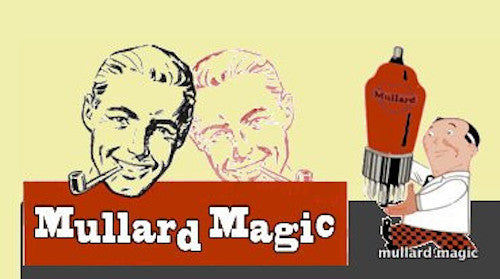
VALVE TYPES & MANUFACTURING TECHNIQUES (iv) - TUNGSTEN WIRE
Share
OK, for today's blog entry I promise that I am not going to act like a Chemist wonk (even though I am one!) but rather instead, a thermionic wonk ( because I am one as well)!!!!!. Last time, we took a look at Tungsten, an essential commodity used in wire for just about every valve ever made. We left the story at the metallic powdered tungsten stage and picking up the tale again, here we have a nice ex-Mullard photo of a batch of the fine dark grey powdered tungsten leaving one of Mullard Blackburn's reduction furnaces: -

The first stage in the multi stage process of turning this amorphous granular substance into wire is to form it into a solid ingot. This is done by the process of sintering in which the tungsten powder is loaded into moulds, heated to 100 degrees Centigrade in a hydrogen atmosphere and then is subjected to a 100 ton force to compress form an ingot. The ingot is then clamped between platinum electrodes and has a current of 2500A @ 24V passed through it which raises it's temperature to 2700 degrees Centigrade. After ambient cooling, the ingot then posesses a crystal lattice structure that makes it ready for wire making. Below we have a nice ex-Mullard photo of a filled mould being inserted into the ingot press - the ingot so produced would be approximately 35 x 2 x 2 cm in size: -

The next stage of wire making is swaging, where the ingot is reheated to 800 degrees Centigrade and pushed into swaging machine where sequenced pairs of mechanically operated hammers - 11 pairs in total - pummel the ingot whilst it is being rotated such that the tungsten ingot now becomes a tungsten rod some 600 x 0.25 cm in size.
The final stages of wire making is where the tungsten rod is then further reduced by drawing the rod through a sequence of circular tungsten carbide dies, each smaller than the preceding one, the rod is lubricated with a colloidal graphite solution which is sprayed onto the rod pre draw and then removed post draw by running the wire through a boiling caustic soda bath before winding the wire onto a spool. This sequence, lubrication, drawing, cleaning and spooling is repeated until a final wire diameter of 0.5mm diameter is achieved. Below we have a nice ex Mullard photo Tungsten wire being drawn on a chain bench diamond die stock drawing machine: -

From this point on, the dies used are made of industrial diamonds and the wire diameter is successively reduced until the wire achieves the required diameter and so it is that a 35 cm ingot is transformed into 20 miles worth of 8 micron diameter fine tungsten wire ready for use in winding valve grids - but that's another story for another blog entry.
